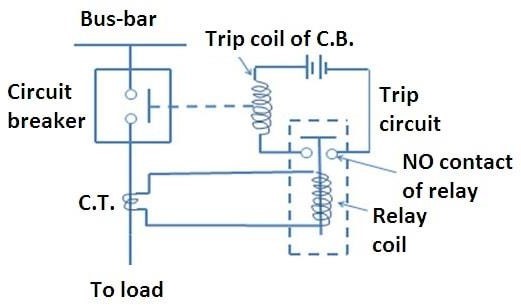Working Principle of a Circuit Breaker with Diagram

Circuit breakers are essential devices used to protect electrical circuits from overloads and short circuits. They act as automatic switches that disconnect power in the event of faults.
What Is a Circuit Breaker?
A circuit breaker is a safety device that automatically stops the flow of electricity in a circuit when a fault (like overcurrent or short circuit) is detected. It helps prevent electrical fires, equipment damage, and system failures.
Working Principle of Circuit Breaker
The operation of a circuit breaker is based on detecting abnormal current levels and quickly disconnecting the circuit to avoid damage.
Explain in Step By Step.
Normal Operation
- Current flows from the bus-bar through the circuit breaker to the load.
- A current transformer (C.T.) monitors the flow of current continuously.
- During normal conditions, the contacts inside the breaker remain closed, allowing electricity to pass.
Fault Detection
- When there is a fault (e.g., overload or short circuit), the C.T. detects unusually high current.
- It sends a signal to the relay coil.
Relay Activation
- The relay coil gets energized.
- This closes the Normally Open (NO) contact in the relay.
- Closing the NO contact completes the trip circuit.
Trip Coil Operation
- The trip coil of the circuit breaker gets powered.
- It mechanically opens the breaker’s contacts, cutting off the power supply.
- The arc produced while opening the contacts is extinguished by an arc-quenching system.
Load Is Protected
- The faulty circuit is isolated.
- The system is now safe from overheating, fires, or equipment damage.
- The breaker can be reset after fixing the fault.
Circuit Breaker Diagram
Key Point.
- C.T. – Current Transformer
- NO Contact – Normally Open Contact
- Relay Coil – Activates trip signal
- Trip Coil – Breaks the circuit
- Bus-bar – Main power line
- To Load – Output to connected devices
Why Are Circuit Breakers Important?
✅ Prevent electrical fires
✅ Protect devices from damage
✅ Easy to reset after tripping
✅ Used in homes, industries, and power stations
Conclusion
Understanding the working principle of a circuit breaker is vital for anyone involved in electrical systems. With the help of the above diagram and explanation, you now know how faults are detected and how circuit breakers protect your home and devices.